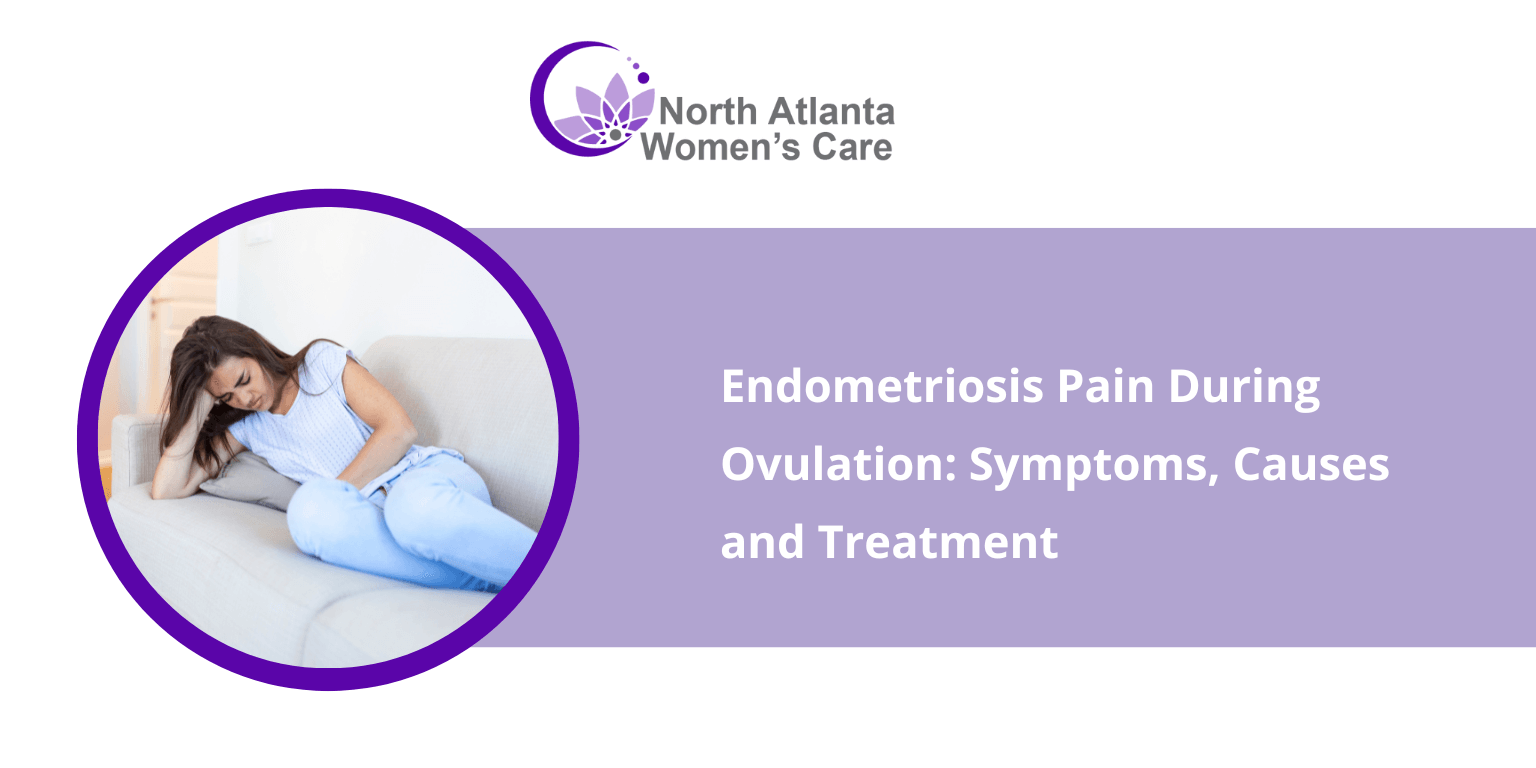Endometriosis Pain During Ovulation: Symptoms, Causes and Treatment

Imagine waking up every month to a wave of pain, disrupting your daily life. For many women, this isn’t just a bad case of menstrual cramps. It’s endometriosis, a condition where tissue similar to the uterine lining grows outside the uterus. This tissue can lead to discomfort, particularly during ovulation.
Endometriosis doesn’t just cause physical pain—it impacts emotional well-being and can complicate fertility. In the United States alone, about 11% of women of reproductive age suffer from this condition, affecting their overall health and quality of life.
Understanding endometriosis is the first step toward managing it. With proper diagnosis and treatment, including medication, lifestyle changes, and in some cases, surgery, it’s possible to alleviate the symptoms and reclaim control over your life.
Let us start with learning more about endometriosis pain during ovulation, the factors behind it, and some useful management strategies.
Understanding Endometriosis and Ovulation
Endometriosis involves the growth of endometrial-like tissue outside the uterus, causing inflammation, pain, and scar tissue formation. This unusual tissue can be found on the ovaries and fallopian tubes. Due to hormonal changes, pain often intensifies during menstruation and ovulation.
Ovulation is a phase in the menstrual cycle when an egg is released from the ovary. This process is due to hormonal changes, mainly concerning estrogen and progesterone. During ovulation, these hormonal fluctuations can heighten endometriosis symptoms, resulting in endometriosis cramps during ovulation.
What Are the Symptoms of Endometriosis?
There are various endometriosis symptoms during ovulation. These signs might sometimes be confused with menstrual pain. However, some symptoms are specific to this condition. These may include:
- Chronic pelvic pain: Persistent pain in the pelvic region, often worse during menstruation.
- Painful periods (dysmenorrhea): Severe menstrual cramps that may begin before and extend several days into a period.
- Pain during intercourse: Discomfort or pain during or after intimacy.
- Pain with bowel movements or urination: Symptoms may be especially severe during menstruation.
- Excessive bleeding: Heavy menstrual periods (menorrhagia) or bleeding between periods (menometrorrhagia).
- Infertility: Endometriosis is sometimes first diagnosed in those seeking infertility treatment.
What Causes Endometriosis Pain During Ovulation?
Pain during ovulation can be intense for individuals with endometriosis. Several factors contribute to this increased pain, from hormonal changes and physiological responses. Knowing these factors can help handle and reduce the discomfort associated with ovulation.
- Hormonal Changes: Fluxes in estrogen and progesterone during ovulation can activate endometriotic lesions, leading to inflammation and pain.
- Pelvic Congestion: Increased blood flow to the pelvic region during ovulation can cause pelvic congestion.
- Inflammation: Chronic inflammation from endometriotic lesions can worsen pain during ovulation.
- Nerve sensitization: Endometriosis can lead to nerve damage and sensitization, making the pelvic area more sensitive to pain signals during ovulation.
- Adhesions and scar tissue: Adhesions and scar tissue from endometriosis can restrict the movement of pelvic organs, leading to increased pain during ovulation due to the stretching and pulling of these tissues.
How to Diagnose Endometriosis?
Diagnosing endometriosis can be difficult due to its varying symptoms. However, certain tools and examinations can be used to identify the symptoms and find effective treatment for this condition. Some of the common ones are:
- Medical history and symptom review: A medical professional will review the severity and onset of the symptoms along with your medical history.
- Pelvic examination: The professional checks for abnormalities such as cysts on reproductive organs or scars behind the uterus.
- Imaging tests: Ultrasound or MRIs are used to get a detailed view of endometriotic lesions and their extent.
- Laparoscopy: This minimally invasive surgical procedure involves a surgeon inserting a laparoscope through a small incision in the abdomen and getting a detailed view of the pelvic organs.
What Are the Treatments for Endometriosis?
Managing endometriosis often requires a combination of treatments tailored to alleviate symptoms and improve your living conditions. Below are common treatment options available to manage the symptoms:
- Pain relief medications: Nonsteroidal anti-inflammatory drugs (NSAIDs) may help relieve cramps.
- Hormonal therapy: Hormonal medications (birth control pills) and therapy options could help in pausing or reducing menstrual symptoms.
- Surgical options: Minimally invasive surgeries or options (laparoscopy and hysterectomy) like removal of cysts and uterus may be opted for in serious conditions.
- Alternative therapy: Complementary options like acupuncture or herbal medications could improve blood flow, reduce inflammation, and relieve endometriosis symptoms during ovulation.
- Pelvic floor exercises: Strengthening the pelvic floor muscles through specific exercises can help reduce pain and improve pelvic health.
- Lifestyle adjustments: Including lifestyle changes like an anti-inflammatory diet (nuts, green vegetables, fatty fish, and berries) and regular exercise can help manage the symptoms.
Practical Tips for Pain Management During Ovulation
Managing endometriosis pain during ovulation can be challenging, but several practical strategies can help reduce endometriosis pain during ovulation. Here are some useful tips to consider:
- Heat therapy: Using hot water bags and warm baths can help relax muscles and reduce pelvic pain during ovulation.
- Medicines: Over-the-counter medications and drugs can help relieve pain and reduce discomfort.
- Hormonal management: Birth control pills, patches, or rings can help regulate hormonal fluctuations and reduce ovulation pain.
- Light exercises: Light stretching, meditation, and exercises can help in relaxation and relief.
- Avoiding strenuous activities: Avoiding excess physical activities and exercises is necessary during ovulation.
Read More: How to Cope with Endometriosis
When to Consult a Healthcare Provider?
In case of persistent pain or aggravating symptoms, one must contact a healthcare provider immediately. Regular checkups are also necessary to manage endometriosis and its symptoms.
Effective Management Strategies for Endometriosis Pain During Ovulation
Managing endometriosis pain during ovulation requires an all-around approach, including lifestyle changes, complementary therapies, and medical treatments. Individuals can better manage their symptoms and improve their quality of life by incorporating dietary adjustments, gentle exercise, stress management techniques, and appropriate treatments.
Expert Treatment for Endometriosis Pain at North Atlanta Women’s Care
At North Atlanta Women’s Care, we specialize in providing comprehensive treatment and care for women’s health conditions. Our expert healthcare services include treatment for heavy periods, infertility, high-risk pregnancy, and other symptoms of endometriosis. Contact us today and gain freedom from endometriosis pain during ovulation.
Comments are closed

